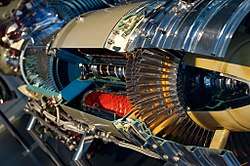Allison T56
| T56 / Model 501 | |
|---|---|
| Type | Turboprop |
| National origin | United States |
| Manufacturer | Allison Engine Company Rolls-Royce plc |
| Major applications | Convair 580 Grumman C-2 Greyhound Lockheed C-130 Hercules Lockheed P-3 Orion Northrop Grumman E-2 Hawkeye |
| Number built | >18,000 |
| Developed from | Allison T38 |
The Allison T56 is a single-shaft, modular design military turboprop with a 14-stage axial flow compressor driven by a four-stage turbine. It was originally developed by the Allison Engine Company for the Lockheed C-130 Hercules transport[1] entering production in 1954. It has been a Rolls-Royce product since 1995 when Allison was acquired by Rolls-Royce. The commercial version is designated 501-D. Over 18,000 engines have been produced since 1954, logging over 200 million flying hours.[2]
Design and development

The T56 turboprop evolved from Allison's previous T38 series.[3] It was first flown in the nose of a B-17 test-bed aircraft in 1954.[3] One of the first flight-cleared YT-56 engines was installed in a C-130 nacelle on Lockheed's Super Constellation test aircraft in early 1954.[4] Originally fitted to the Lockheed C-130 Hercules, the T56 was also installed on the P-3 and E-2/C-2 aircraft, as well as civilian airliners such as the Lockheed Electra and Convair 580.[3] A major setback occurred when a T56-A-1 engine delivered to Lockheed in May, 1953, produced only 3,000 hp, not the required 3,750 shp needed for the C-130. A further setback occurred in August 1953 when an engine being tested failed after only 6 ½ hours run time. A redesign of the engine failed during testing in September of the same year. A second redesign was more successful. Evolution of the T56 has been achieved through increases in pressure ratio and turbine temperature. The T56-A-14 installed on the P-3 Orion has a 4591 shp rating with a compression ratio of 9.25:1 while the T56-A-427 fitted to the E-2 Hawkeye has a 5250 shp rating and a 12:1 compression. In addition, the T56 produces approximately 750 lbs of thrust from its exhaust.[5]
A marinised turboshaft version, the 501K engine, is used to generate electrical power for all U.S. Navy cruisers and destroyers currently in commission.[2]
An engine enhancement program to reduce fuel consumption and decrease temperatures was approved in 2013, and the US Air Force expects to save $2 billion and extend the C-130 fleet life.[6]
The Lockheed Martin C-130J Super Hercules which first flew in 1996, has the T56 replaced by the Rolls-Royce AE 2100, which uses dual FADECs (Full Authority Digital Engine Control) to control the engines and propellers.[7] It drives new six-bladed scimitar propellers from Dowty Rotol.
Variants
- 501-D13
- (Series I) Lockheed L-188 Electra and Convair CV-580 (Replacing P&W R-2800) starting December 1957
- 501-D13A
- (Series I) Similar to -D13
- 501-D13D
- (Series I) Similar to -D13
- 501-D13H
- (Series I) Similar to -D13
- 501-D22
- (Series II) Lockheed L-100 Hercules
- 501-D36A
- (Series II) (non-type certified)
- 501-D22A
- (Series III)
- 501-D22C
- (Series III) similar to -D22A
- 501-D22G
- (Series III) similar to -D22A
- 501-M62
- Company designation for the T701-AD-700 turboshaft engine to power the Boeing-Vertol XCH-62 Heavy-lift helicopter

- T56-A-7
- (Series I)
- T56-A-8
- (Series I)
- T56-A-9
- (Series I)
- T56-A-9D
- (Series I) Lockheed C-130A Hercules Starting December 1956 and on all Grumman E-2A Hawkeyes from 1960
- T56-A-9E
- (Series I) Similar to -A-9D
- T56-A-10W
- (Series I) with water injection
- T56-A-7A
- (Series II) Lockheed C-130B Hercules Starting May 1959
- T56-A-7B
- (Series II) Similar to -A-7A
- T56-A-10WA
- (Series II)
- T56-A-14
- (Series III) Lockheed/Kawasaki P-3/EP-3/WP-3/AP-3/CP-140 Aurora from August 1962
- T56-A-15
- (Series III) Lockheed C-130H Hercules from June 1974
- T56-A-16
- (Series III)
- T56-A-425
- (Series III) Grumman C-2A Greyhound from June 1974
- T56-A-14+
- (Series 3.5) Fuel efficiency and reliability upgrade, Lockheed WP-3D Orion from May 2015.
- T56-A-15+
- (Series 3.5)
- T56-A-16+
- (Series 3.5)
- T56-A-425+
- (Series 3.5) Northrop Grumman E-2 Hawkeye from August 2011
- T56-A-427
- (Series IV) Northrop Grumman E-2 Hawkeye upgrades from 1972
- T56-A-427A
- (Series IV) similar to the -A-427
- T701-AD-700
- (501-M62) Turbo-shaft engine for the Boeing-Vertol XCH-62 Heavy-lift helicopter.
Applications
Specifications (T56 Series IV)
Data from Rolls-Royce.[8]
General characteristics
- Type: Turboprop
- Length: 146.1 in (3,711 mm)
- Diameter: 27 in (690 mm)
- Dry weight: 1,940 lb (880 kg)
Components
- Compressor: 14 stage axial flow
- Combustors: 6 cylindrical flow-through
- Turbine: 4 stage
- Fuel type: JP8
Performance
- Maximum power output: 4,350 shp (3,244 kW) limited to 4,100
- Turbine inlet temperature: 860°C
- Fuel consumption: 2,412 pounds per hour
- Power-to-weight ratio: 2.75:1 (shp/lb)
See also
Related development
Comparable engines
Related lists
References
- ↑ Global Security T56
- 1 2 "Rolls Royce T56 Product Sheet" (PDF). www.rolls-royce.com. Archived from the original (PDF) on 2013-02-07. Retrieved 2012-11-02. Retrieved on 1 November 2012.
- 1 2 3 "Global Security T56publisher=www.globalsecurity.org". Retrieved on 1 November 2012.
- ↑ https://www.flightglobal.com/pdfarchive/view/1954/1954%20-%201209.html?search=april%20t56%20test-bed
- ↑ "The Rolls-Royce Allison T56 is fifty" (PDF). New Zealand Aviation News, September, 2004. Archived from the original (PDF) on 2014-10-21. Retrieved 2013-11-02. Retrieved on 2 November 2013
- ↑ "NOAA 'Hurricane Hunters' First To Get T56 Series 3.5 Engine Enhancement" Aero News, November 14, 2013. Accessed: December 1, 2013.
- ↑ "Rolls Royce AE-2100 Product Sheet" (PDF). www.rolls-royce.com. Archived from the original (PDF) on 2013-02-17. Retrieved 2012-11-02. Retrieved on 1 November 2012.
- ↑ Rolls, Royce . Training Manual . T56/501D Series III. Rolls-Royce, 2003. 8-1 To 8-24. Print.
External links
| Wikimedia Commons has media related to Allison T56. |